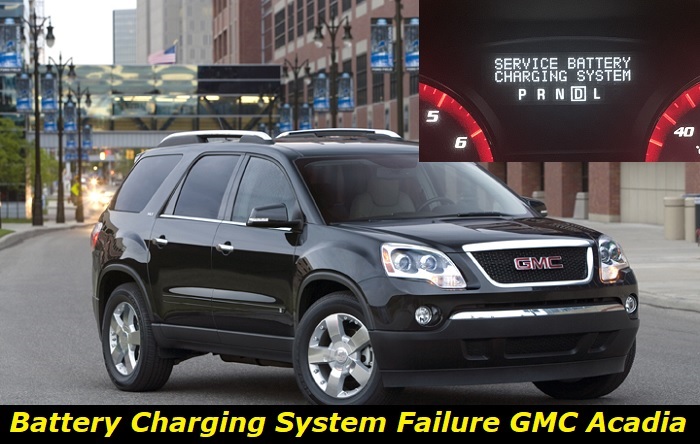The last thing you want from your car is to find the dashboard displaying error messages. One frustrating message you don't want to see is the service battery charging system. This can be very painful especially when you need your car urgently. Since driving with this error notification is not a good idea to not risk getting stranded during your journey.
Service battery charging system message highlights
- Common reasons:alternator issues,battery problems, loose wiring
- How to fix:check the battery, check the alternator, check the wires and connections
- Possible consequences:complete battery loss, inability to start the engine
- Priority level:High
- Can you drive?Yes
- DIY repair:Possible
- Repair price range:$0-$1,000

What is a battery charging system?
Depending on the age of the vehicle, different automobiles have different battery charging systems. The electronic control unit, the battery, the computer, the wiring, and the alternator make up most cars' charging systems.
Before the 1990s, charging systems in vehicles required a voltage regulator to maximize the alternator's performance. As soon as the car's engine began to operate, the alternator began to produce energy, and the voltage began to flow through the system. Every time there is an imbalance in the voltage, the battery light in this system illuminates.
As cars evolve, manufacturers discovered that replacing voltage regulators with a computer that delivers precise voltage measurements was a better solution. When the computer notices a change in the system's voltage in newer battery charging systems, the battery light would turn on.
The components of this system are described below:
- The Battery
The battery in the automobile functions as a sort of bank for the electricity produced by the alternator. It gives the energy needed to start the car's engine from its reserve of energy. When the car's engine is off or there's an alternator malfunction, it supplies the connected accessories with power.
- The Alternator
An alternator produced electric current in a car like a generator and is an essential part of the battery charging system. Apart from some hybrid vehicles, all cars hosting an internal combustion engine have an alternator. The alternator charges the battery while the engine is running and provides additional electricity to the car's electrical systems. The movement of an engine-fitted alternator is driven by a component known as the serpentine belt. This belt is important to the purpose of the battery charging system and is considered when testing for faults.
An alternator does not need to be maintained and can run without maintenance for as long as 15 years. The car might still work for a while, running on the power from the battery if the alternator fails. Nevertheless, once the power on the battery is exhausted the vehicle stalls.
- The Electronic Control Unit
By controlling how the electrical power in the automobile is distributed, the electronic control unit manages the electronic system. It effectively regulates how much electricity the car's alternator produces. It must also determine when the car battery needs to be charged and when the energy flow of the vehicle needs to alter.
- The wiring
This part consists of the wiring and connections between the other components of the battery charging system.
Why is my Battery Charging System Light On?
When the battery charging system light is on, it is an indication of a fault in the system. Finding a mechanic shop for repair is the best thing to do as the car can break down at any time. However, these faults can be due to certain defects in the component of the engine. The common causes of the battery charging system error are:
- Failed Drive belt: The warning light may turn on if the drive belt fails, which prevents the alternator from performing its function. Ask your mechanic to examine the drive belt in your car. It can be broken and require replacement.
- Wiring and connector issues: Ask your mechanic to check the battery clamps for tension and condition and to clean all the connections. Ask them to examine all the connections and wirings within the alternator as well as all the fusible links to see if any are burnt. Get them fixed if they are damaged.
- Damaged Alternator: When the service charging system/battery light lights, the alternator is often the cause of the issue. Have the voltage flowing from your alternator checked by a professional. Your mechanic will probably replace your faulty alternator with a new one if the voltage is low. The alternator is usually long-lasting but, in this case, must be replaced immediately.
- Battery faults: Your battery may be low and in need of replacement if your battery/check charging system light is on. Bring your car in for a battery strength test, then get it done. Also, make sure the light was not triggered by a disconnection from the battery.
- Faulty control unit:Because it controls the voltage the alternator produces, the electrical control unit, often known as the computer, is essential to how the battery charging system functions. Any electrical control unit issues will have an impact on voltage regulation and turn on the check charging light.
How to fix the service battery charging system light
One solution for the battery/check charging system light going on is to inspect the charging system yourself. You may take a step on the right path. So, regardless of the model of the vehicle, here's how you can inspect your charging system. Here's what you should do if you need to service a battery charging system on a GMC Acadia, for example.
1) Examine the battery
The goal is to ensure that the vehicle's battery is in good shape and completely charged. Examine the battery's hydrometer to see whether there is a green visible light. You should also ensure that the battery terminal connections are free of corrosion residue and securely attached. Wipe off any residue or rust from the battery terminal.
Check the voltage at the battery terminals as well. When there are no loads, it needs to be around 12 volts. You may also use a test light or multimeter to confirm that the battery is fully charged. If the voltage is not correct or around the value above, your battery might be the fault. Here is a breakdown of how you can examine the integrity of your battery using a test light or multimeter:
- Start by flipping the battery tester to the OFF button.
- Then switch the multimeter selector to the DV volt position
- Next is connecting the tools to the positive battery socket. Connect the negative lead to the negative connector on the battery. You should also make sure that the multimeter clips are in direct contact with the battery connectors.
- Adjust the load control knob to the right for the ammeter to measure half of the battery's cold cranking amps.
- Next is to examine the multimeter reading. The reading is temperature-dependent and the temperature must be kept at room temperature range. For instance, a reading of 9.6V at 21°C is the standard. This value represents suitable battery health. Getting a value that goes below the standard can be an indicator of a faulty battery. However, before finalizing the fate of the battery.
- Another step to take is to Check the Alternator.
2) Test the Alternator
After checking the car's battery for any defects, you can also check the alternator. Here are the steps to follow if you intend to service the battery charging system of your vehicle:
- Switch OFF all the power-connected components in the vehicle.
- Place the shift selector in NEUTRAL and use the parking brake to keep still.
- Load and non-load tests should be implemented.
- Adjust the tester to read ammeter functions.
- Connect the positive and negative leads to the corresponding connectors on the battery.
- The B+ output of the alternator should point in the direction of the current probe's location.
- Set the battery tester's voltmeter settings.
- Grind the negative lead while arranging the positive lead of the voltmeter to connect to the alternator's B+ terminal.
- Ascertain that all electrical gadgets are turned off.
- Maintain the voltage between 14.0 and 15.0 volts when the engine is operating at 2,000 rpm.
3) Examine the other components
Most of the troubles of your GMC Acadia can be solved with proper testing. If you have examined the two major components of the battery charging system (Alternator and Battery) and couldn't find any fault, you should examine the other components.
Other components to examine include the wiring of the battery charging system and the electronic control unit. While checking the other components, you should check the serpentine belt as well, it is responsible for regulating the speed of the alternator. A crack or break in this belt should also be checked.
Conclusion
A battery charging system light indicates that there's a problem with the charging of a car's battery. While in operation, the car switches to use the power on the battery and once exhausted will stall.
Therefore, it is important to understand how servicing battery charging system works. If your vehicle's battery charging system light comes on, this article describes the step to take in handling it.
About the authors
The CarAraC research team is composed of seasoned auto mechanics and automotive industry professionals, including individuals with advanced degrees and certifications in their field. Our team members boast prestigious credentials, reflecting their extensive knowledge and skills. These qualifications include: IMI: Institute of the Motor Industry, ASE-Certified Master Automobile Technicians; Coventry University, Graduate of MA in Automotive Journalism; Politecnico di Torino, Italy, MS Automotive Engineering; Ss. Cyril and Methodius University in Skopje, Mechanical University in Skopje; TOC Automotive College; DHA Suffa University, Department of Mechanical Engineering






Add comment